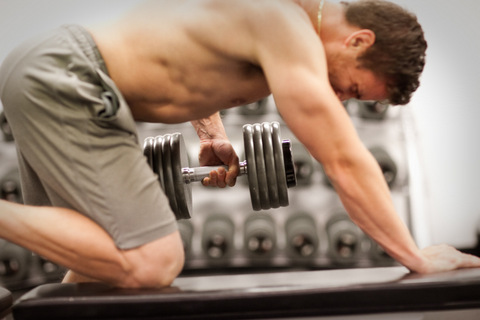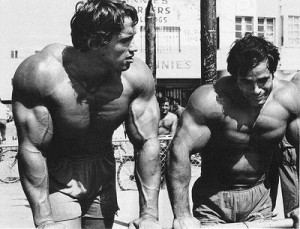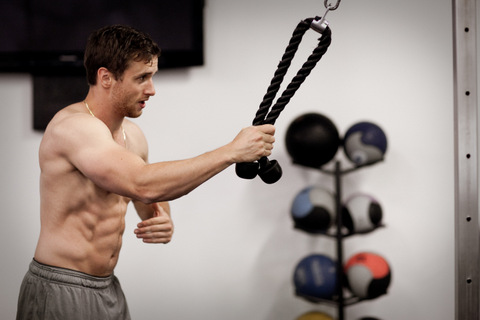The Pump & Single Limb Training
The best program is the one you’re not doing.
Confused? Well, simply put, the most effective rep range, exercises, sets, and tempos, are those that we’re not doing right now. Why? Because our bodies are too damn amazing to allow training to be so simple as to go to the gym, work hard, and walk out with the perfect body.
We need variation. Now, the statement above can be taken the wrong way, as I witness daily in guys who have no rhyme or reason to their training. Randomness isn’t the solution, structured variation is. In every muscle-building program I’ve ever created, changes in reps, cadences, exercises, and sets allow us to see continual muscle growth and fat loss.
In the PowerHowse Challenge we change our entire split – reps, sets, tempos, exercises – every 3 weeks. Each week getting progressively more difficult. They aren’t random changes, but one’s done with a purpose. The’re alterations that differ dramatically from the previous 3-week split as to “shock” our muscles and metabolism back into optimal growth. The goal of a workout is to break as much muscle down in as little time possible. Therefore, ffective training is more important than the volume.
In my own training I incorporate a lot of variation in reps and tempo – the two most important variants to have. And, every now and then I do something entirely different that gives my results an added boost. Then, before my body can adapt, I switch it up again, keeping my gains continual.

Over the next couple of weeks I’m doing single-limb training almost exclusively.
What does single limb training offer?
For one, it’s a remedy for muscular imbalances. It also allows us to focus on one muscle at a time, not just one muscle group that has two parts at the opposite sites of our body (i.e. the deltoids, arms, legs are all relatively far apart from their counterparts). By focusing on our left deltoid, for example, we bring all the blood and lactic acid to this one area, breaking down the muscle even more effectively than we would otherwise.
We can also keep our mind on one muscle at a time. When focusing on the right bicep while doing a curl, for example, we can insure that this movement is perfect. Our mind can be in one place, working on one muscle, making sure we’re doing the exercise exactly how it should be done.
Single limb training is a great break up from our normal routine. For those of you who are doing the PowerHowse Challenge, altering your exercises in this way is a lovely change-up, furthermore guaranteeing that you never see a plateau in your training. I’ll give a few examples of alterations you can make at the end of the article.
Curing Muscular Imbalances
Next time you have a squat day, pay attention to your hips. Better yet, grab a buddy and get him to film your squat. You may notice that at the bottom of the lift, your hips tilt to either side. After performing squats for hundreds of thousands of reps over your lifting career, this tilt shows itself in visible – and not so visible – muscular imbalances.
You might see the imbalances in the head’s of your quads, where they attach to, and surround your knee cap. Your upper quads may be a different size. You may even have one leg that’s stronger than the other. I’m sure we can notice this with our arms.
The imbalances I have – and had – also have a lot to do with sports. I was right handed in basketball, so the tens of thousands of jumpshots I took gave me more strength in my right arm. Then, in boxing I’m an orthodox fighter, with my left shoulder at the front of my stance. The jab being the punch thrown more often than any other, gave me tightness and greater development in my left deltoid and trapezius muscle.
Instead of using a bar to do the upright row, I’ll use dumbbells, and I’ll focus on one muscle at a time. The single arm dumbbell floor press is also a great variation from the barbell floor press when correcting imbalances in our detloids, traps, and more specifically our shoulders.
THE PUMP!
We’ve all experienced the gloriousness that is, “the pump”. The skin splitting, arm busting amount of blood that can fill up a muscle at the height of a workout. Well, the pump isn’t just a good feeling, a confirmation that we’re working hard, it’s good for our gains as well.
By feeding our muscles more blood, we bring to them more muscle-building nutritients and hormones. Those micro-tears we’re creating when working out, need to recover if they’re ever going to repair – and grow. My bringing more nutritients to the muscles we’re training, we’re expediting the recovery process and upping its quality.
We’re also increasing the delivery of oxygen-rich blood cells to our muscles which rids them of toxins like immonia. This, coupled with the nutrients being delivered by the increased bloodflow makes for an great invironment for recovery.
On TOP of all this, the increased blood flow better delivers our pre and post workout nutritients to the areas that need them most: the muscles we’re working.
So where does single-limb training work into this? Well, for starters, single-limb training isn’t the only way to go, but it IS a great variation to our regular exercises. It’s a great way to cure imbalances. But it’s also a way to intensify our pump. By focusing on one muscle – literally one muscle, like the left bicep – at a time, we create an atmosphere where all of our blood will go to this muscle. Thus, we can experience an even greater pump than with our usual set – within a set.
The Set-up
Adding single-limb exercises to your routine is simple. Replace your barbells with dumbbells, and use one arm or one leg to do the same – or a similar exercise. The workout should be completely the same.
You’re not focusing on one muscle in a workout, but rather on one muscle in a set, each set being “supersetted” to include each muscle and it’s counterpart. I’m confusing myself now. What I mean is that where you’d normally do squats, do a split squat. Use the same rep counts, but use a lighter weight, do one leg first, then the other. You can use a bar with your lower body, or dumbbells, it’s completely up to you.
How to Change Your Exercises
Most of this should be common sense. Instead of bench press, do a single arm dumbbell press. Instead of barbell curls, do a single-arm dumbbell curl.
A few other alterations:
Squat —> split squat, step ups, single-leg leg press/hack squat (one leg at a time)
Straight leg deadlift —-> use dumbbells to do a single-leg Romanian deadlift
Triceps pushdown —–> still use a cable, but use a handle, with your palm either facing down or up (both work the muscle in a different way).
Chin-ups —–> single arm pulldowns. Use a lighter weight, a handle (not the bar), and remain strict with your form.
Conclusion
Single limb training isn’t the be all end all. But it is a very effective method of building ripped muscle that few of us use. Everything we see in the gym, and that we’ve been taught in our training employs both limbs. If, however, you want to get sore in your next workout and cure some of those muscular imbalances, change up your training (even just a few exercises) to use one arm or leg.
